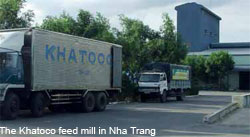Khatoco evolves from cigarettes to feed milling

Khanh Viet Corporation is a state-owned company in Khanh Hoa Province in Vietnam. Its international trading name is Khanh Viet Corporation, its abbreviation is Khatoco. Established in 1983 the organisation started with handmade cigarettes. Since then it has branched out and is now the biggest local company in central Vietnam.
Khatoco is one of the top companies in the government assigned Vietnamese tobacco industry, manufacturing around 550 million packets of cigarettes per year. Using the accumulated capital of the tobacco industry Khatoco has diversified into other industries. From the results of rearing ostriches and crocodiles as an experiment, in 2003, Khatoco set up a new business: an ostrich farm in Quang Nam. Many high-quality products made from the meat, leather, feathers and eggs of these birds find their way to the domestic market and for export. Soon after that pig farming was taken up as an enterprise. From these ventures also a feed mill was established.
World player ambition
Driving into Nha Trang, an hour’s flight north of Ho Chi Minh City you pass a convention centre that still proudly displays a large colourful banner emblazoned with the words “Miss World Competition 2008”. Vietnam wants to be a world player and is a flourishing country. Living standards are improving and hence demand for pork and other meats are increasing. The Khatoco feed mill is located near Nha Trang, Khanh Hoa province. Many Vietnamese companies are joint ventures between the government and investors, but the Khanh Hoa feed mill is 100% government-owned. Khatoco is an integrated company and owns a large pig farm of over 2,000 sows and an ostrich farm. Feed for both these enterprises is being sourced from the corporation’s feed mill which started production in December 2006. The corporation’s ostrich farm is Vietnam’s biggest and operates as a joint stock company. Initially, a pilot project was set up. This was successful as the birds adapted well to the local climate and now Khatoco breeds between 1,500 and 2,500 birds on its three farms and also owns three processing plants. The corporation is also setting up two chicken layer operations which will have a total of 200,000 birds plus it is expanding its pig business. A lot of duck feedThirty per cent of the mill’s 2,500 tonne monthly output is supplied to the corporation’s pig and ostrich farms, with the remaining 70% being sold to other farms. Vietnam has a substantial duck farming sector and 40% of the mill’s output is in the form of duck feed. Another 40% goes to pig feed with the remaining 20% being taken by ostrich and broiler enterprises.
The mill produces eight different pig rations, mainly in 4mm pelleted form. Energy sources are corn, cassava (local, Indian and American), rice bran and wheat bran. Protein sources are soybean meal (Argentinean and Indian), full-fat soy, Peruvian and local fishmeal. Skimmed milk powder and whey feature in the creep diets along with plasma, whilst haemoglobin is added to grower feeds.
90 employees
The mill operates 6 days a week. Nguyen Thien Phong is the mill director responsible for the 90 employees, whilst technical matters are the responsibility of Tran Quang Hai. Much of the milling and mixing equipment was bought from Dutch company Van Aarsen. The installed hammer mills have a throughput of 10 tonnes per hour. The horizontal mixers hold 2 tonnes and mix a batch in 6 minutes. Finished feeds are hauled in 20-tonne trucks up to 200 km from the mill and customers are required to pay up front before the feed is delivered. Pig feeds are distributed mainly in 25kg bags although some creep feed is packed in smaller 5kg bags. Mycotoxins are a problem and so inhibitors are added to feeds. Raw materials are regularly tested for mycotoxin contamination which involves sending samples to France and Switzerland for checking. Feeds are supplemented with synthetic lysine, tryptophan and methionine where necessary along with phytases. AGPs can be added to certain rations but only under veterinary prescription.











